To be cheated out of another thousand, or more, vertical feet of champagne light Selkirk powder is bad enough, but Dave’s hard edged comment struck the core of the matter. Though powder is the elixir of glisse, the people we share it with matter the most. Dave was pissed that his time skiing with Ruedi Beglinger, the Rued-man, was cut short. Who could blame him. The fact is, I had come back to this place to experience, again, why Ruedi was so strongly respected among ski mountaineers.
Setting the Bar
It took awhile for me to understand his enigma, but the answer came loud and clear on a slush slog through the Monashee mountains in the spring of ’96. As usual, it was a motley blend of personalities and relationships whose common denominators were mountains, skiing, and a guide. Even a clod could see that this particular blend of characters might not mesh without the presence and the reason for our weekly acquaintance, Ruedi Beglinger. The cast included a father-son team from Prince George, a couple from Idaho, a local from Rossland, B.C., and what seems a mandatory ingredient on any tour to British Columbia, a group from Seattle. Despite the vast range of social, economic, and cultural differences among the group, we got along marvelously. This was no small feat when you consider that, in the snow conditions we encountered, even good friends could have been reduced to a group of snarling bitches.
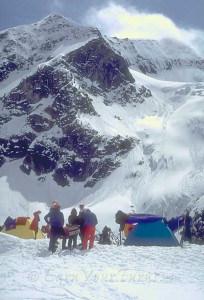
After 3 days of water rich precipitation on a traverse of the Monashee range the sun shines and the avalanches let loose, blocking our traverse.
It certainly doesn’t sound like much fun, but the fact of the matter is, we spent the day digging a huge snow pit in an attempt to create shelter from the freezing rain while telling jokes. We laughed until our sides hurt. Only weeks earlier I had shared fresh tracks through peerless Selkirk powder with a different group of relative strangers, lumped together for the same basic reason, and yet, while the snow conditions were far better then, the camaraderie was not.
The difference was the caliber of mountaineer present on each trip. A few weeks earlier there were a few people who were clearly in over their head, literally and technically. But on this trip everyone present had a lot of experience. So much so that a novice would wonder why anyone present would even bother to hire a guide. But then, I’m not talking about an ordinary guide.
Genuine Swiss Cred
Ruedi Beglinger was born in Switzerland in 1958. Early on he knew that he wanted to be a guide. At age 19 he was an associate guide, and was fully certified and working in Switzerland by 22. By 1980 he had decided to move to Canada where his first year found him working summers as a tool and die maker, then heli-guiding in the winter. But his heart was in the backcountry, so he began the process of getting a permit to build a backcountry hut near Revelstoke, BC.
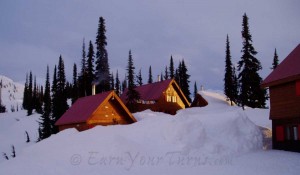
What started as a single Chalet is now a compound. Sauna and the Beglinger house lit up, just the corner of the Chalet is visible on the right.
On the subject of guiding Ruedi says, with a German accent, “the first most important ting is tak-nical ability, and safety. The guide must know navigation, snow contitions, rescue, everyting tak-nical. Personality is second.”
Guiding with family
While even Ruedi believes personality should come second, I must report that it is not as distant a second as some would insist. On my last two visits to Revelstoke I was taken aback at the friendliness and joviality that uRudi showed, not only towards me, but several of his other clients. He keeps a respectful distance, but his sense of humor is far stronger than my first impression revealed. More importantly, he has a very strong love for his wife, Nicoline, and two daughters, Charlotte and Farina. Last year I had the privilege of seeing him, not only with his immediate family, but with his parents as well. While I didn’t understand a lick of the German they spoke among themselves, the level of cooperation and respect we all witnessed was evidence of a much deeper bond.
With Dad around it was easy to see where Ruedi gets his stamina. Ruedi senior is in his 70’s and had no problem staying ahead of us sloths at the back of the pack, whether we did 5,000 or 7,000 vertical feet in a day. Admittedly he only went out every other day, but even so, we were the ones panting to keep up.Experience matters
The reason for Ruedi’s insistence on technical competence has been proven on more than one occasion in his understanding of snow conditions. Last year he began the week of January 11th with a warning that the snowpack was unpredictable. Naturally we figured this was standard propaganda to keep us in line. A few hours later we topped out on Woolsey peak and the sunny side of the slope beckoned for the inexperienced to drop in. While everyone else was changing from uphill to downhill mode I decided to walk along the ridge a ways to snap a picture. My steps sent out a minor shock wave and we all watched in amazement as that entire sunny slope broke only 20 feet beneath us and began cascading out of sight. Ruedi’s words suddenly had meaning. Then, only an hour later, while headed back to the chalet the group, again, topped out on a ridge and triggered two avalanches across the valley. To the naked eye they looked like small slabs, but closer inspection two days later revealed that they were nearly eight feet deep.
At the dinner table that night Ruedi explained that there was a hard crust that was created with a warm storm back in mid November. He said we would have to be very cautious that week. Later he told me that he was afraid that there was going to be an accident somewhere in the range that week. Two days later two skiers were killed while heli-skiing in the Monashees as this same layer let go. How did he know? Ruedi prefers to make avalanche predictions on a physics based mechanical model, rather than studying snow crystals, as is currently taught.In the past few years he has added snowboarding to his platter, and has stepped headlong into the quest for the ultimate snowboard touring setup. His conclusions so far? Snowshoes are out, at least for the depth of powder the Selkirks get, short, fat approach skis are bearable, and the concept of the split board is hands down the best compromise going. As a mountaineer first, skier second and snowboarder last, it is a foregone conclusion that he prefers hard boots. He quickly dismisses a soft setup, saying, “iff you’re in the moan-tans you vant a moan-tan-eering boot,” he says with finality. But then he shares his logic, “iff you’re in da aavf-ah-lanch, with hard boots, you chust lean ofer, und, bingo,” he flips the toe latch on a plate binding to demonstrate, “you can get out. With soft boots you’re stuck. You’re dead.”
Why the switch to snowboarding? He looked at his client base and realized that they were all older. True, a week at Ruedi’s chalet is not in the budget of most young snowboarders, but he could see that he needed to be prepared for a shift down the road. While this addition of snowboard mountaineering to his menu of guiding services is calculated with Swiss precision, it is actually driven more by the infectious enthusiasm that every rider carries with him in descent.
While atop Mt. Ruth and admiring the view of Mt. Moloch, the most beautiful peak in Ruedi’s “backyard” I asked him if he had done it yet. It has an upper snowfield that begs for tracks and though it looks benign and quite doable, the fact that it funnels into a single, narrow couloir through a band of 300 foot cliffs and is pitched at an average of 48° puts it in the realm of extreme. “No,” he said, , “But vhen I do it, I’ll use a snowboard.”
Catering to the core, not pandering to the weak
While most guides bend to the limitations of the weakest link in the group, Ruedi keeps his sights high. If you can’t keep up, Ruedi makes sure you don’t hold up the group anymore than one day. Fortunately there are always enough guests that a second guide is on hand to lead those who want a more relaxed pace. On my first trip to Ruedi’s Durrand Glacier Chalet we were thankful to have not made the grade and still found life on the B-team to be filled with more peaks and turns than we would have bagged if left on our own.
Ruedi knows the satisfaction that comes from doing multiple peaks and descents in a day. Most ski guides simply look for the great ski runs. Ruedi insists on bagging and skiing from the peaks. Indeed, the consistent smile he wears on every peak, no matter how hard the spin drift might blow in his face, is evidence enough that Ruedi is totally at home whenever he stands atop a mountain. As a guide, Ruedi has made it his job to insist on sharing that. Sure it is tough on most of us weekend warriors, but we also know that it is the challenge that we need to purge the toxins of our everyday lives. And what better way to do it than by trying to keep up with Reudi Beglinger, a man to whom climbing and skiing three, seven, even 10-thousand vertical feet in a day is not out of the question.
Even if you are prepared for it, a day with Ruedi will be long, arduous, and unrelenting. But that is precisely why the experienced, adventurous mountaineer will seek Ruedi out. They don’t want to play patty-cake in the mountains, they want to make maximum vertical and maximum turns. With the Rued-man, they know they’ll get it.
This article was first published in Couloir Magazine,Volume X-2, Nov. 1997
© 1997

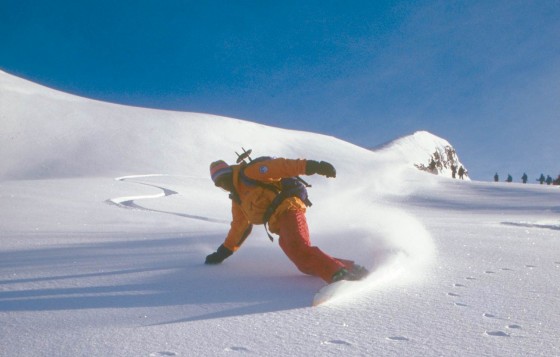
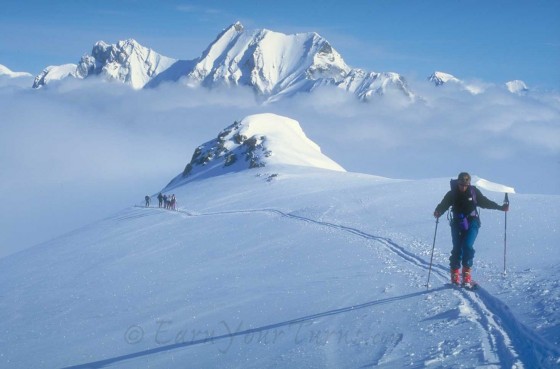
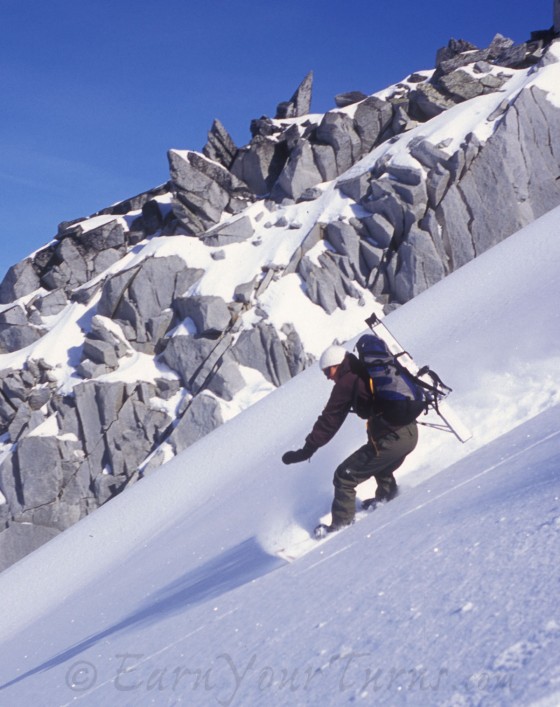
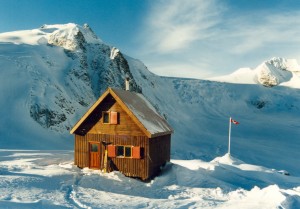
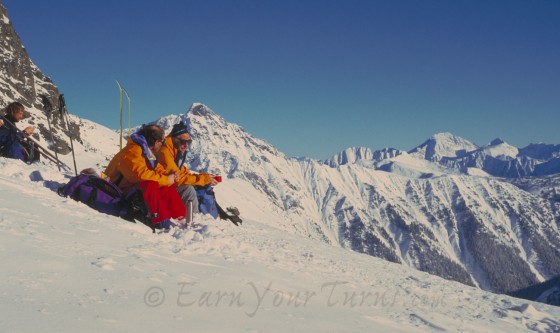
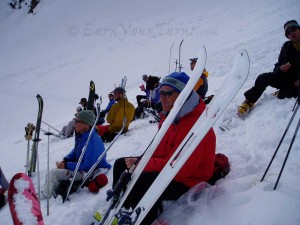

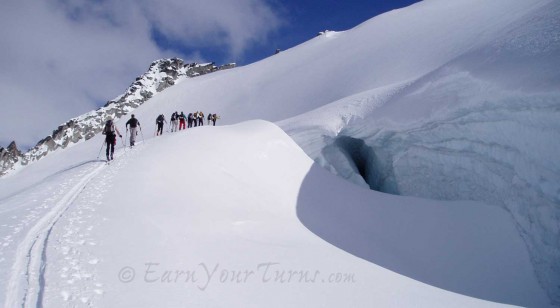
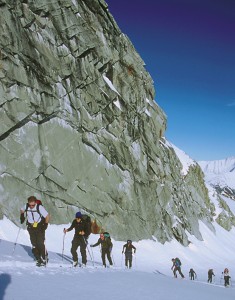
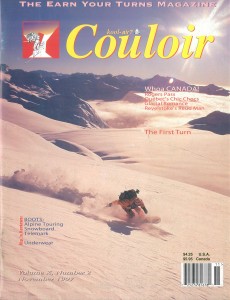
1 ping
[…] the tragedy on Tumbledown Mountain, January 20th, 2003. Seven people died in one fell swoop as Ruedi Beglinger, lead guide and owner of Selkirk Mountain Experience, led 21 people in pursuit of skiing’s […]